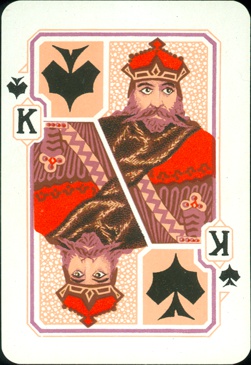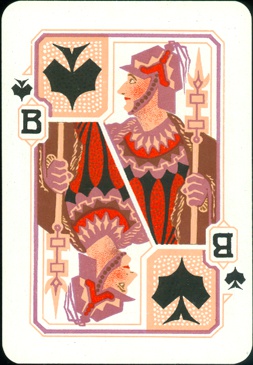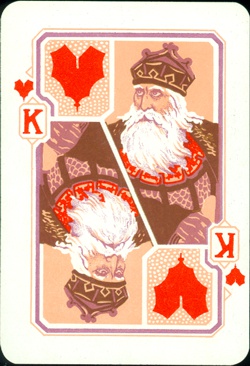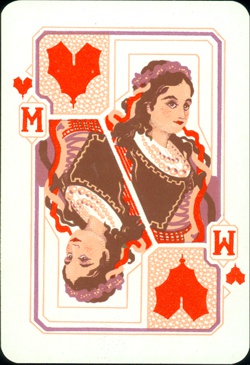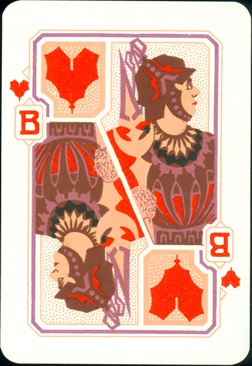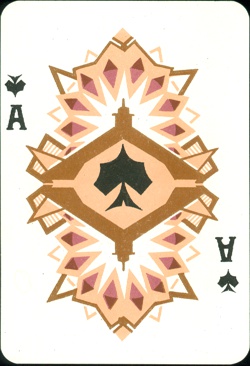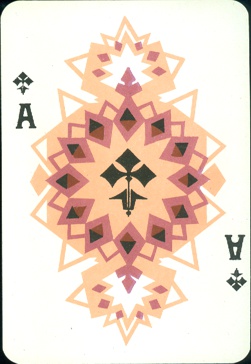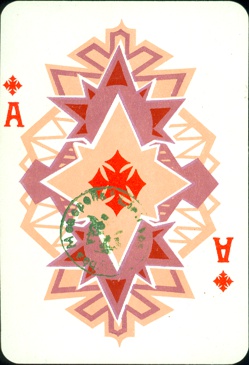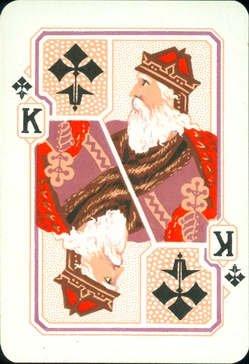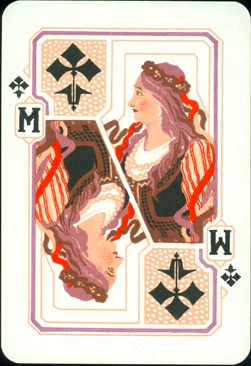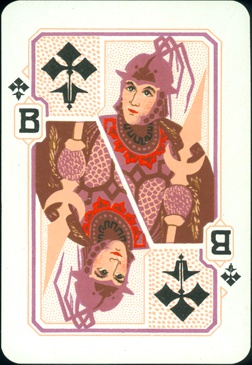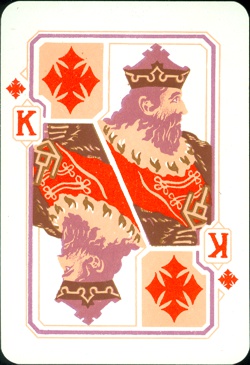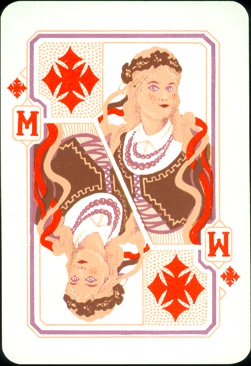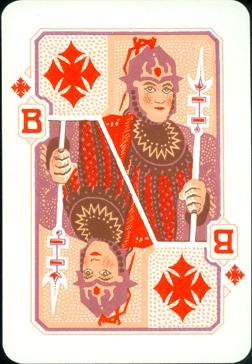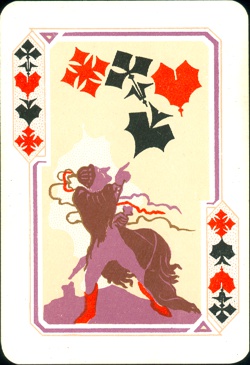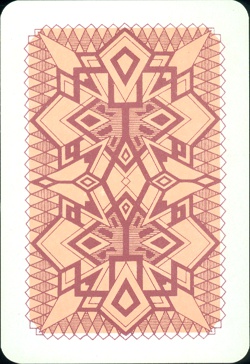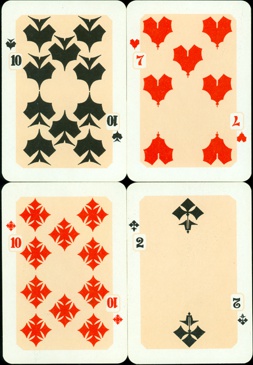August
2018
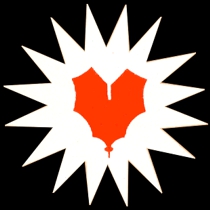 |
After
several months of sorting out our newly acquired collection, we've
finally come to a nicer stage: sorting the decks for our own collection
by country and only checking a few duplicates to see if they are an
improvement of our own decks. The rest are all new to us and there are
some surprising decks. In the last week of this month we came across
three nice Lithuanian decks and we had a hard time deciding which deck
to show here. |
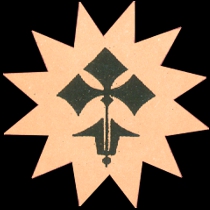
|
We could have
shown any of these three decks here, they all had special and exciting designs
on the courts. The choice was between the Vaivorykste deck (also known as "Höffische Spiel")
and a pretty similar designed deck, called Klubams (for clubs). Klubams fell off
the table and we chose the joker from the Vaivorykste (Rainbow) deck as Joker of
the Month. So for this spot we went for the "Gedimino Stulpai"
deck. It were the unusual layout and the special designed pips that tipped
the scale.
As our knowledge
about Lithuanian decks is just as limited as the decks in our present
collection, we looked at the WWPCM site and the WOPC site. They both mentioned
Spindulys Printing House as manufacturer of 6 decks, of which the 3 decks
mentioned above are part. The information about the decks and the pictures on
the WOPC site were for the greater part provided by Albinas Borisevicius and the
information about the manufacturer came from Tadas Jurys.
Lithuania is one
of the 3 small Baltic states, but has covered a much larger area in the past.
Around 1400 it was one of the largest countries in Europe. Halfway the 16th
century it formed a commonwealth with Poland and this lasted until the end of
the 17th century, when the commonwealth was partitioned by Russia, Prussia and
Austria. Most of Lithuania was occupied by the Russian empire and this lasted
until the end of WW I, when Lithuania became an independent state again. Not
long before WW II started it was occupied by the Russians and during WW II by
the Germans. After the war had ended Lithuania became a Soviet Republic under
control of the Russian Soviet Union again until independence was declared in
March 1990. Since May 2004 it's a member of the European Union.
The Spyndulis
printing house, situated in Kaunas, was formed by combining 3 print shops:
Svyturis, Varpas and Raides. Spyndulis started their production in 1928 and is
still active at the present moment, but mainly as a book printer. The card
production stopped after WW II. Our chosen deck here was printed around 1930 and
published as "Gedimino Stulpai", which is translated as "The
Columns of Gediminas".
Gediminas was the Grand Duke of Lithuania from around 1315 until his death in
1341. He is seen as one of the most important figures in Lithuanian history: the
Grand Duke who literally "made Lithuania great again". Under his reign
Lithuania expanded and stretched from the Baltic Sea to the Black Sea. The
Columns (or Pillars) of Gediminas refer to an ancient Lithuanian symbol and once
the Lithuanian coat of arms. The symbol is in appearance close to the trident.
The suit symbols in the deck are said to be variations of the trident.
|
The suit symbols of the spades have been placed upside down. At first we
thought that this might have been done by mistake, but then we saw that
the pips on the joker showed the same upside down presentation of the
spades symbol. So maybe it's the designer's idea of a variation of the
trident?
|
|
On the
WOPC site Tadas Jurys mentions that at
that time the playing-card designers were Mstislavas Dobužinskis
(1875–1957) and Barbora Didžiokienė (1896 - 1976). We couldn't
find any name or initials, but probably one of them was responsible for
these designs.
. |
|
|
The
aces are all embellished with rather spiky, Art Deco like designs. For the scan we've
placed the central spades symbol in its upright position, but guess that
it should have been used upside down too. There's a Lithuanian tax stamp
on the AD. Peter Endebrock dates it as c1925, but it was probably in use
until 1944. The full text reads "Lietuvos
Valstybes Monopolio Kortos" (Lithuania State Playing-card
Monopoly).
. |
|
By now you
must have wondered where the abbreviations K, M and D on the courts
stand for. At least we did and as we didn't find any answer on the WOPC
or the WWPCM sites, we turned to a fellow IPCS member, Janis Metra, for
information. He told us that the K in Lithuanian stands for Karalius
(king), the M for Mergele (maid/virgin) and the B for Berniukas
(fellow). Here the aces are indicated by an A, but in Lithuanian decks a
T for Tuzas (aces) can also be found.
.
|
|
There's one other thing still puzzling us, maybe a designer's thing too:
on all the courts the large pips are set against a brownish background with white
dots or a white one with brownish dots, except for the KS and the KD,
with their solid brownish background. Understandable on the KS, because
it would become the same as the background of the head next to it, but
on the KD??
.
|
|
The deck consists of 52 cards
and a joker. The back design also exists in green. The special designed
pips are used on all cards too.
.
|
|
BACK TO PRESENT
MONTH


